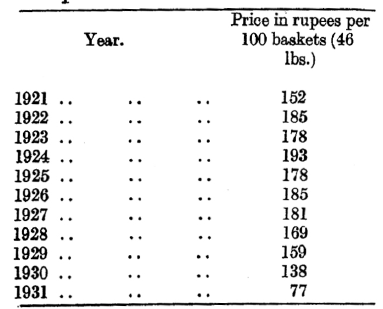Census India 1931: The Population Problem in Burma
This article is an extract from CENSUS OF INDIA, 1931 Report by J. H. HUTTON, C.I.E., D.Sc., F.A.S.B., Corresponding Member of the Anthropologische Gesselschaft of Vienna. Delhi: Manager of Publications 1933 (Hutton was the Census Commissioner for India) Indpaedia is an archive. It neither agrees nor disagrees |
Census India 1931: The Population Problem in Burma
The census of Burma was taken on February 24th two days earlier than that of India proper on account of local festivals which made the 26th an inconvenient date. Though only eighth in order of population figures, Burma is by far the largest of the piovinces, of the Indian Empire, having an area of 261,610. square miles, of which 233,492 were covered by the census operations of 1931. The population censused is 14,667,146, having increased by 11 per cent. since 1921, part of which increase, as near as can be estimated 320,000* persons, is due to immigration from India.
The figures in the marginal table give the variation by " naturally ’’ divisions, but these divisions are administrative and racial rather than geographical. Thus the Burman Division represents the plains districts of administered Burma in which the population is primarily (94 per cent.) Burmese, though it includes the remnants of the Mons of Pegu, the main bulk of the Karens, who appear also in the Salween and Shan divisions in smaller numbers, and a considerable share of the total number of Chins, Kachins and other indigenous races. It contains nearly all the Chinese other than Yunnanese, that is to say almost two-thirds of the total, and practically all the other foreign or Indo-Burmese population. The Chin division contains for practical purposes Chins and no one else. The Salween division, consisting as it does primarily of the Karenni, the only area in Burma with the status of an Indian State, has a population purely Karen and Tai.
The Shan division, constituted by the Northern and Southern Shan States, is of course primarily Tai, but includes a good many Karens and Burmans, almost all the Yunnanese (who make up more than a third of the total Chinese in Burma), almost the whole of the Palaung-Wa branch of the Mon-Khmer race, many Kachins, about half the other indigenous races of Burma, and a few Indians. The immigration of Yunnanese during the decade has been considerable and has added about 10,000 to the population of the Northern Shan States, while Indians, largely Gurkhas from Nepal, have added another 11,000 to the Northern and 5,000 to the Southern Shan States. In the Salween division the population of the Karenni States decreased, and the increase in the rest of that division was largely due to the mines in Salween District.
The Chin division has increased not only by the natural growth during a prosperous decade but by the inclusion of previously unadministered country on the Assam border. As far as climatic conditions went the decade was normal and floods and droughts were confined to small areas and involved no widespread calamities comparable with those which befell some parts of India, though the town of Pegu was destroyed by a disastrous earthquake which did damage elsewhere as well.
Burma grows more rice than her population consumes, and although cultivable land is not readily capable of extension the area under irrigation was extended by some 317,000 acres during the decade. Industrial expansion, particularly in the production of oil, has been important in some districts and railways have extended by 434 miles. There has been some increase in mining activity in spite of the slump in silver and baser metals. The fall in the price of paddy was perhaps the most serious feature of the decade economically.
The marginal table shows the wholesale prices of paddy brought by boat to Rangoon annually from January to March. After a very considerable rise from the 1921 prices, the price fell in 1929 nearly to the 1921 level, in 1930 considerably below it and in 1931 dropped to half. The past decade witnessed a very rapid growth of national feeling in Burma.
This feeling tended to take a racial bias and showed itself particularly strong against Indians and Chinese, manifesting itself against the former in the Rangoon riots of May 1930, and against the latter in a riot in January 1931. With these came the rebellion, of which the Burma General Administrative Report for 1930.31 writes :— "The outbreak of a sudden and prolonged rebellion came as a surprise. It began on 22nd December 1930 in Tharrawaddy (75 miles north of Rangoon), a turbulent district since Burmese times and in these latter years a favourite resort of political agitators.
Military Police were despatched in twenty-four hours, and regular troops followed, but by May 1931 there had been outbreaks in Prome, Yamethin, Pyapon, Henzada, Thayetmyo and attempted outbreaks elsewhere. The rebels were tatooed in order to render them invulnerable, and many wore simple uniform, for the rising was organised. Its object was the overthrow of Government and the enthronement of a jungle king, for in its prime origin it had little to do either with modern politics or with economic stress. It was aggravated by, just as in its turn it proceeded to aggravate, economic stress, but it originated in an outburst of medimval superstition of a recurrent and recognisable type."
The outbreak coincided, of course, with the census, but luckily the preliminary enumeration could everywhere be completed in undisturbed conditions except in Tharrawaddy District and a small part of Pegu, where there was inevitably some under-enumeration. The rebellion spread to Henzada before the final enumeration, but the preliminary enumeration had already been completed.
